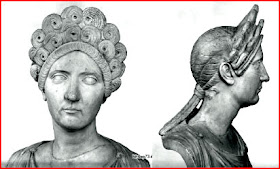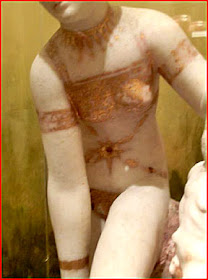Just like a woman...
... elegance of appearance, adornment, apparel – these are the woman's badges of honour; in these they rejoice and take delight; these our ancestors called the woman's world.
That what Livy (34.7.8-9), perhaps the greatest of Roman historians, said ... and he knew what he was talking about. At least, he knew what was what when the subject was about men: their offices, priesthoods, triumphs, decorations, gifts, and spoils of war. About the women's world, well, not so much. Although, in one basic matter, he was right: women had no equivalent public honours. Accordingly, he assumed that their obsession with bodily appearances was compensation for their lack of civic repute.* So, what mattered most to them was how they looked ... gussied up with silks and jewels and other female frippery. This was the only public statement that a woman could make, the only way she could boost her status and command respect outside the home.
 Let women have gold in their bracelets and covering their fingers and on their neck, ears and tresses, let gold chains run at random round their waists; and let little bags of pearls hang invisible suspended by gold chains from their lady owners' neck, so that even in their sleep they may retain the consciousness of possessing gems : but are even their feet to be shod with gold, and shall gold create this female Order of Knighthood, intermediate between the matron's robe and the common people? (Pliny, N.H. 33.40)
Let women have gold in their bracelets and covering their fingers and on their neck, ears and tresses, let gold chains run at random round their waists; and let little bags of pearls hang invisible suspended by gold chains from their lady owners' neck, so that even in their sleep they may retain the consciousness of possessing gems : but are even their feet to be shod with gold, and shall gold create this female Order of Knighthood, intermediate between the matron's robe and the common people? (Pliny, N.H. 33.40)Needless to say, any opulent public display of gold and pearls and gems was also taken as a sign of dubious morals, bringing out the worst qualities in women (greediness, extravagance, and vice).
Just like a woman, really.
Higher in bling, she was inevitably lower on the moral scale than men and accordingly a creature of lesser virtue. Both figuratively and, as some would say, literally:
There is nothing that a woman will not permit herself to do, nothing that she deems shameful, when she encircles her neck with green emeralds, and fastens huge pearls to her elongated ears....(Juvenal, Satire 6)But did the Roman woman really conform to this pattern?
Of course, the feminine virtues admired in Roman society were chastity, modesty, fertility, beauty, and fidelity -- all virtues in favour of a woman's husband and family. Those are the virtues reflected in representations of women. Wearing too much jewellery was believed to contradict feminine virtues and could be seen as suggesting loose morals -- which means that the absence of jewellery in itself could be meaningful. On the other hand, jewellery could also demonstrate a woman's status and her husband’s and his family’s wealth. And it must be said, some kinds of jewellery positively supported female virtues, such as green gemstones favouring fertility, pearls rewarding motherhood (only to be worn by women with three or more children) and engagement rings pointing to marital status.
So, what was an elite Roman woman to do? To bling or not to bling?
It's time to find out.
In her Master's thesis, just completed at Leiden University (Diadems: a girl’s best friend? Jewellery finds and sculptural representations of jewellery from Rome and Palmyra in the first two centuries AD), Ms Andrea Raat delved into this perennial conflict from two different viewpoints:
First, she set out to discover what kind(s) of real jewellery has been buried with men or women in the area of Rome, and the social position of the owner(s). The precious metals and gems she studied come from sarcophagi and tombs in ten identified burials, found around and on the bodies.** All date from the first century CE to the end of the second century CE.
Then, she asked about what kind(s) of jewellery are pictured on statues of Roman women of roughly the same dates.
What jewels do they wear and what kind of woman is wearing them? Sculptural representations express both a person's identity and a social role forever fixed in a specific pose, gesture, attributes, dress and adornment. So Ms Raat went to the Musei Capitolini in Rome and studied the statues of women there shown wearing jewellery of any kind, from the first two centuries CE: of 145 female statues from this period, only 15 meet these criteria. That is to say, ca. 10% wear jewellery; 90% not.
Next, she asked what are the similarities and differences between the buried jewellery and that depicted on sculpture?
Reality versus image, really.
As if that isn't a big enough subject, she then went on to visit Palmyra, home of Queen Zenobia (but a little earlier than her reign)....
From Rome to Palmyra
The procedure was the same: looking at real jewellery from tombs and then the ornaments pictured on sculpted grave monuments. Did she find the same patterns there as at Rome? And would these indicate the similar aspirations of elites living at the centre of empire and those living far away on its eastern frontier in Syria? Were the Palmyrans bijoux copy-cats, or did they go their own way in matters of personal adornment?
So, what did Ms Raat discover?
The Imperial Capital First
In the nitty-gritty of the Roman tombs, 49 pieces of jewellery were found -- from bracelets to brooches, from hairpins and hairnets (below, left), to necklaces and very popular finger-rings, too.
Most objects are of gold or gold combined with a precious stone. In nine of the ten burials, the skeleton could be sexed and all were female. So, it seems pretty clear that jewellery in such Roman burials is linked to the female gender. When the age at death could be estimated (three cases) as well, they turned out to be under 20 years of age. That leads to the hypothesis that all of these female burials are of young, unmarried women:
Normally jewellery was not placed in graves, but formed part of a dowry and was passed on from one generation to the next. When a girl died before she had arrived [at] marriage and motherhood, this chain of traditions was broken, making it an accepted practice to let the girl take her jewellery to the grave.As for the social status of these young women, the richness of jewellery finds and other grave goods in the burials suggest that they belong to affluent and socially significant families.
That's how these young women looked in death. What does the sculpture say?
First, remember that of the 145 sculptures in our sample, just 15 (ca. 10%) are pictured wearing any kind of jewellery. Five of them had real metal jewellery attached (earrings fastened to the pierced earlobes; as above, third image down) or had holes in their ears where it once real earrings had been attached. And ten statues had jewellery in sculptured form but only, remarkably, of one single type: diadems!
Here is Livia, wife of the Emperor Augustus (above). The decoration of her elaborate diadem includes relief ears of wheat, which alludes to her identification with the divine goddess of agriculture, Ceres. Five more imperial women also wore diadems (one representing Venus and one Artemis), but no one managed to out-diadem Livia. Sabina, wife of Hadrian (below), didn't even try.
Two women with diadems are of unclear status and one was definitely not an imperial lady but she had herself sculpted as the goddess Fortuna. One more was a priestess (below), who also wore a richly decorated diadem:
So, what does this say about the type of women who were portrayed wearing diadems?
While the diadem can refer to the imperial sphere, that is not always the case. In fact, it seems more strongly connected with the religious sphere. Besides the priestess with the diadem, three diademed imperial women and one certain non-imperial woman with a diadem are represented as goddesses. The diadem can therefore be associated with the divine, as if this type of jewellery were a divine attribute.
The fact that the diadems on Roman female statues were connected with the religious sphere apparently made it an accepted piece of public adornment. Obviously, these women would have possessed an awful lot of jewellery in real life, but they wouldn't have wanted to show off their riches on their statues (at least nothing more than occasional earrings or a diadem). Most probably, the 90% of women pictured without any jewellery at all were praised as representing female virtues. More jewellery than earrings or a pious kind of diadem would probably have warranted the same criticism as showing off their jewels in public, namely an accusation of female vice.
So, when in Rome, elite ladies were commemorated in public, they would wear only the most limited and stereotyped forms of jewellery -- or none at all -- and so they presented the female ideal.
In the next post, we'll move on to Palmyra -- where things could not have been more different.
* Commonly ornamenta referred to the status, title, honours and costume (including decorations) granted to a specific rank. For men these were ‘badges of honour’ operating in the public political or military sphere (e.g. ornamenta consularia or ornamenta triumphalia). Ornamenta muliebra or feminarum (‘female ornaments’), on the other hand, are confined to personal items of decoration.
** The jewellery finds for this study consist of the collection of jewellery on display in the `Luxury in Rome´ section of the Palazzo Massimo alle Terme, part of the Museo Nazionale Romano. It comprises well conserved valuables mostly found in a grave context with known excavation records.
My thanks to the blog History of the Ancient World for signalling this fascinating Master's thesis from Leiden.
Illustrations
All are taken from Andrea Raat's Master's thesis.
1. Plotina (aka Pompeia Plotina Claudia Phoebe Piso), wife of the emperor Trajan (r 98-117). The marble bust of a woman (Plotina?) with a diadem sculpted from hair; Trajan period (Musei Capitolini).
2. A woman is helped getting dressed. Fresco, first century AD, Pompeii (Museo Archeologico Nazionale di Napoli). Wealthy women made use of a special ornatrix, a female slave responsible for making her mistress’ toilet, with hairdressing as main task.
3. Bronze statuette head of a divinity with a gold and pearl earring (Museo Nazionale Romano).
4. Detail of a marble statuette of Venus with painted golden jewellery and bikini from Pompeii (Museo Archeologico Nazionale di Napoli).
5. Marble portrait head of Livia; Museo Capitolino, Stanza degli Imperatori 9. Inv. 144.
6. Marble portrait of Sabina; Museo Capitolino, Salone 44. Inv. 338.
7. Marble portrait of a priestess (from a relief); Palazzo dei Conservatori, Braccio Nuovo III 16. Inv. 2688 (2539.158). Discovered in 1938 during excavations at the Mercati Traianei (Trajan’s markets).
.
.
.







